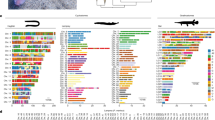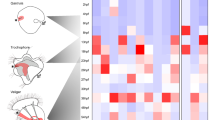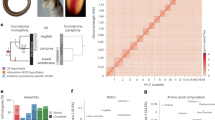Abstract
The clustered organization of Hox genes provides a powerful opportunity to examine gene gain and loss in evolution because physical linkage is a key diagnostic feature which allows homology to be established unambiguously. Furthermore, Hox genes play a key role in determination of axial and appendicular skeletal morphology1,2 and may be a key component of the evolution of diverse metazoan body forms. Despite suggestions that changes in Hox gene number played a role in evolution of metazoan body plans3,4, there has been a general lack of evidence for such variation amongst gnathostomes (or indeed any vertebrate) and it has therefore been widely assumed that differential regulation may be the key element in all vertebrate Hox evolution. We have studied the Hox gene clusters of a teleost fish, Fugu rubripes, to test the possibility that Hox organization may have varied since the origin of jawed vertebrates. We have identified four Hox complexes in Fugu and found an unprecedented degree of variation when compared with tetrapod clusters. Our data show that: Fugu clusters are widely variant with respect to length; at least nine genes have been lost; there is a new group-2 paralogue; and pseudogene remnants of group-1 and group-3 paralogues were found in the Hoxc complex, when compared with the present mammalian clusters. We show that gene loss after duplication of the prototypical vertebrate Hox clusters is a key feature of both tetrapod and fish evolution.
This is a preview of subscription content, access via your institution
Access options
Subscribe to this journal
Receive 12 print issues and online access
$209.00 per year
only $17.42 per issue
Buy this article
- Purchase on Springer Link
- Instant access to full article PDF
Prices may be subject to local taxes which are calculated during checkout
Similar content being viewed by others
References
Krumlauf, R. Hox genes in vertebrate development. Cell 78, 191–201 (1994).
Burke, A.C., Nelson, C.E., Morgan, B.A. & Tabin, C. Hox genes and the evolution of vertebrate axial morphology. Development 121, 333–346 (1995).
Lewis, E. A gene complex controlling segmentation in Drosophila. Nature 276, 565–570 (1978).
Akam, M. Hox genes and the evolution of diverse body plans. Philos. Trans. R. Soc. Lond. B Biol. Sci. 349, 313–319 (1995).
Nelson, J. Fishes of the World 1–600 (John Wiley & Sons Inc., New York, 1994).
Tyler, J., Osteology, phylogeny and higher classification of the fishes of the order Plectognathii (Tetraodontiformes). NOAA Tech. Rept. NMFS Circ. 434, 1–122 (1980).
Pollock, R.A., Sreenath, T., Ngo, L. & Bieberich, C.J. Gain of function mutations for paralogous hox genes — implications for the evolution of hox gene-function. Proc. Natl. Acad. Sci. USA 92, 4492–4496 (1995).
Pollock, R.A., Jay, G. & Bieberich, C.J. Altering the boundaries of Hox3.1 expression: evidence for antipodal gene regulation. Cell 71, 911–23 (1992).
Horan, G. et al. Compound mutants for the paralogous Hoxa-4, Hoxb-4, and Hoxd-4 genes show more complete homeotic transformations and a dose-dependent increase in the number of vertebrae transformed. Genes Dev. 9, 1667–1677 (1995).
Jegalian, B.G. & De, R.E. Homeotic transformations in the mouse induced by overexpression of a human Hox3.3 transgene. Cell 71, 901–910 (1992).
Nonchev, S. et al. The conserved role of krox-20 in directing Hox gene expression during vertebrate hindbrain segmentation. Proc. Natl. Acad. Sci (USA) 93, 9339–9345 (1996).
Marshall, H., et al. A conserved retinoic acid response element required for early expression of the homeobox gene Hoxb-1. Nature 370, 567–571 (1994).
Aparicio, S. et al. Detecting conserved regulatory elements with the model genome of the Japanese puffer fish, Fugu rubripes. Proc. Natl. Acad. Sci. USA 92, 1684–1688 (1995).
Popperl, H. et al. Segmental expression of Hoxb-1 is controlled by a highly conserved autoregulatory loop dependent upon exd/pbx. Cell 81, 1031–1042 (1995).
Brenner, S. et al. Characterization of the pufferfish (Fugu) genome as a compact model vertebrate genome. Nature 366, 265–268 (1993).
Graham, A., Papalopulu, N. & Krumlauf, R. The murine and Drosophila homeobox gene complexes have common features of organization and expression. Cell 57, 367–378 (1989).
Zeltser, L., Desplan, C. & Heintz, N. Hoxb-13 — a new hox gene in a distant region of the hoxb cluster maintains colinearity. Development 122, 2475–2484 (1996).
Duboule, D. Guidebook to the Homeobox Genes. 284(Oxford University Press, Oxford, 1994).
Vanderhoeven, R., Sordino, P., Fraudeau, N., Izpisuabelmonte, J.C. & Duboule, D. Teleost hoxd and hoxa genes — comparison with tetrapods and functional evolution of the hoxd complex. Mech. Dev. 54, 9–21 (1996).
Garciafernandez, J. & Holland, P. Archetypal organization of the amphioxus Hox gene-cluster. Nature 370, 563–566 (1994).
Misof, B.Y. & Wagner, G.P. Evidence for 4 Hox clusters in the killifish fundulus-heteroclitus (teleostei). Mol. Phylogenet. Evol. 5, 309–322 (1996).
Misof, B.Y., Blanco, M.J. & Wagner, G.P. PCR-survey of Hox-genes of the zebrafish — new sequence information and evolutionary implications. J. Exp. Zool. 274, 193–206 (1996).
Scott, M.P. Vertebrate homeobox gene nomenclature. Cell 71, 551–553 (1992).
Pendleton, J., Nagai, B.K., Murtha, M.T. & Ruddle, F.H. Expansion of the Hox gene family and the evolution of chordates. Proc. Natl. Acad, Sci. USA 90, 6300–6304 (1993).
Acampora, D. et al. The human HOX gene family. Nucl. Acids Res. 17, 10385–10402 (1989).
Altschul, S., Gish, W., Miller, M., Myers, E.W. & Lipman, D.J. A basic local alignment search tool. J. Molec. Biol. 215, 403–410 (1990).
Church, G. & Gilbert, W., Genome sequencing. Proc. Natl. Acad. Sci. USA 81, 1991–1995 (1984).
Thompson, J., Higgins, D.G. & Gibson, T.J. Improving the sensitivity of progressive multiple sequence alignment through sequence weighting, position specific gap penalties and weight matrix choice. Nucl. Acids Res. 22, 4673–4680 (1995).
Staden, R. An interactive graphics program for comparing and aligning nucleic acid and amino acid sequences. Nucl. Acids Res. 10, 2951–2961 (1982).
Author information
Authors and Affiliations
Corresponding author
Rights and permissions
About this article
Cite this article
Aparicio, S., Hawker, K., Cottage, A. et al. Organization of the Fugu rubripes Hox clusters: evidence for continuing evolution of vertebrate Hox complexes. Nat Genet 16, 79–83 (1997). https://doi.org/10.1038/ng0597-79
Issue Date:
DOI: https://doi.org/10.1038/ng0597-79
This article is cited by
-
Whole-genome duplication in teleost fishes and its evolutionary consequences
Molecular Genetics and Genomics (2014)
-
Consequences of the Evolution of the GABAA Receptor Gene Family
Cellular and Molecular Neurobiology (2005)
-
Evidence for Hox Gene Duplication in Rainbow Trout (Oncorhynchus mykiss): A Tetraploid Model Species
Journal of Molecular Evolution (2005)
-
Evolution of Hox Clusters in Salmonidae: A Comparative Analysis Between Atlantic Salmon (Salmo salar) and Rainbow Trout (Oncorhynchus mykiss)
Journal of Molecular Evolution (2005)
-
Analysis of the conservation of synteny between Fugu and human chromosome 12
BMC Genomics (2003)



